SINGAPORE (Sept 3): The art fair business in Jakarta seems to be on an even keel following the recent conclusion of Art Jakarta. But this could be the lull before the storm that will break out next year when a new fair arrives on the scene, the possible resurrection of a rival show, and another event in the offing.
SINGAPORE (Sept 3): The art fair business in Jakarta seems to be on an even keel following the recent conclusion of Art Jakarta. But this could be the lull before the storm that will break out next year when a new fair arrives on the scene, the possible resurrection of a rival show, and another event in the offing.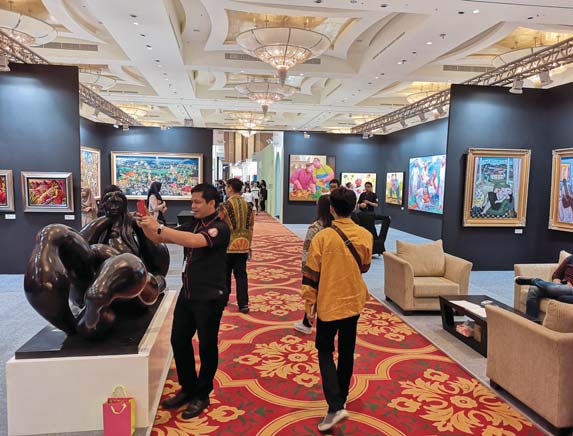
Zola Zolu Gallery occupies several booths and shows predominantly decorative works by Arifien Neif and Richard Winkler.
The cancellation or “postponement” of the third annual edition of Art Stage Jakarta — under the management of Lorenzo Rudolf, principal of Art Stage Singapore — meant that there was no competition for Art Jakarta, which attracted some 50 commercial exhibitors. Local participating galleries included Edwin Gallery, ROH Project, Zola Zolu Gallery, Vivi Yip ArtRoom, CG Artspace, Lawangwangi, Gudang Gambar, Art:1 and Puri Art Gallery. From Singapore, there were Mizuma Gallery, Gajah Gallery, Chan + Hori Contemporary, Art Agenda S.E.A., Art Xchange Gallery and Gnani Art, and from Malaysia, Artemis Art, Wei-Ling Gallery and V’Art Space.
But it is going to be a different story next year with Art Moments scheduled to debut in May at Sheraton Grand Jakarta Gandaria City Hotel, backed by distinguished Indonesian collector and business tycoon Alex Tedja, who owns the venue, According to organiser Leo Silitonga, the new fair will offer the “most competitive” booth rental rates in the region, lower than the current range of US$250 to US$280 per sq m after a 20% to 30% discount.
Art Stage Jakarta is reported to be returning next year, but that remains to be seen.
There is market talk of yet another rival art fair in Jakarta. The proposal is still at the early stage. The principal parties behind the two proposed fairs are trying to sort out plans to collaborate, but at the time of writing, there was no agreement.
The competition for Southeast Asian fair exhibitors will get even tougher when two more art fairs debut in Singapore next year. In January, the locally initiated SEA Focus art showcase of 30 galleries at the Gillman Barracks arts cluster will open during Singapore Art Week. Also touted to resume in January is Art Stage Singapore. And in November, ART SG — backed by international fair veterans AngusMontgomery Arts, Tim Etchells and the MCH Group — will kick off with 80 galleries at the Sands Expo & Convention Centre.
Meanwhile, Art Jakarta is already into its 10th edition and is marketed as “the most prestigious and trustworthy, international-class fine art platform in Indonesia”, purportedly attracting some 32,000 visitors. It was held over four days from Aug 2 to 5 at The Ritz-Carlton ballroom in the Pacific Place mall. The fair was organised by MRA Media, which is under the MRA Group, and spearheaded by business leaders Adiguna Sutowo and Soetikno Soedarjo.
Meanwhile, Art Jakarta is already into its 10th edition and is marketed as “the most prestigious and trustworthy, international-class fine art platform in Indonesia”, purportedly attracting some 32,000 visitors. It was held over four days from Aug 2 to 5 at The Ritz-Carlton ballroom in the Pacific Place mall. The fair was organised by MRA Media, which is under the MRA Group, and spearheaded by business leaders Adiguna Sutowo and Soetikno Soedarjo.
Schneider: The Indonesian art market is still amazingly dynamic.
Rebranding
Initially known as Bazaar Art when it was first held in 2009 under Harper’s Bazaar Indonesia, the fair underwent a name change to Art Jakarta last year as part of a rebranding exercise. It has been held annually at The Ritz-Carlton Jakarta, Pacific Place, within the Sudirman Central Business District. The fair venue is said to have an exhibition space of 7,500 sq m.
Without giving overall figures, the fair claimed in a press release that “Art Jakarta booked an 80% increase in total artworks sales, with the highest sales generated from the El Museo Gallery by Fernando Botero, which was worth IDR12 billion ($1.1 million)”.
According to Art Jakarta fair consultant Gil Schneider, the organising committee does not give any estimates about total sales figures. “We do not collect sales data. Also, many galleries conclude deals initiated during the fair only after its closure. The effect of the fair as a platform for future sales and as a networking facility is as important as deals made during the fair,” he says.
He points out that the local art market is “amazingly dynamic”
“Indonesia is by far the largest art market in Southeast Asia. It has an art collecting tradition which goes back to the Independence period, that is, over 70 years. At the same time, many talented students graduate from art institutions every year, joining the pool of successful artists. Indonesia is an emerging market with a middle class that is growing fast.
“These elements — tradition, output and growing demand — make it so dynamic,” Schneider says.
Formerly with Art Stage Singapore, the Swiss consultant joined Art Jakarta in May last year and advises the organising committee on the “conceptual framework” for the fair.
He says there were 52 commercial exhibitors, excluding special exhibitions, at this year’s fair. “All the top Indonesian galleries and a host of foreign exhibitors joined the fair. It is difficult to put the finger on particular galleries [but] all the major important names contributed to the fair’s success.”
He observes that the visitors were very diverse, from art students to seasoned collectors, families with children to curators or museum directors. “The only common denominator is the appreciation for visual arts, their interest in contemporary art. Many types of artworks were sold, across the entire board,” he adds.
And how is Art Jakarta different from Art Stage Jakarta?
“We are a homegrown fair with a 10- year history, firmly established, made by Indonesians for Indonesians. We run the fair along what we think is the most appropriate format for the local art scene. Indonesia is developing very fast and it is only a matter of years before Jakarta establishes itself as the regional arts hub,” notes Schneider.
“We are a homegrown fair with a 10- year history, firmly established, made by Indonesians for Indonesians. We run the fair along what we think is the most appropriate format for the local art scene. Indonesia is developing very fast and it is only a matter of years before Jakarta establishes itself as the regional arts hub,” notes Schneider.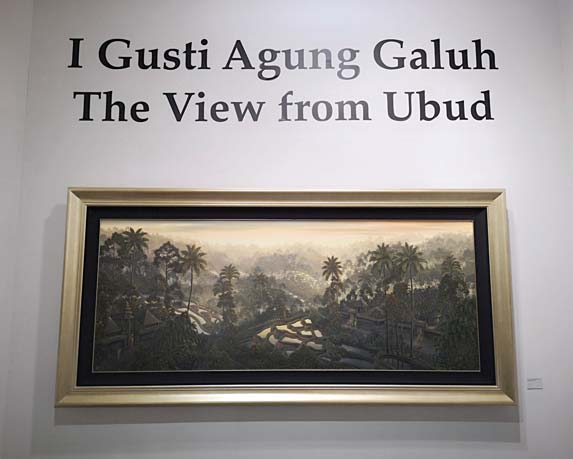
Balinese paintings by I Gusti Agung Galuh offered by Puri Gallery proved to be a hit.
Optimistic
Contrary to Schneider’s opinion, the general mood of exhibitors and visitors at Art Jakarta this year was that the local art market is “slow”. However, there were some optimistic gallerists.
CG Artspace gallery owner Christiana Gouw was among them. She sold all her 30 dog sculptures by Sumbul Pranov at IDR10 million each, and took more bookings. She also exhibited works by other local artists such as Antonio S Sinaga, M Irfan, Meliantha Muliawan and Kemal Ezedine, with prices that went up to IDR250 million each.
“Yes, indeed, I did very well and met many new buyers, most of them with money. I also met some of my old clients who bought from me when I was at Plaza Indonesia. Some of them are celebrities,” says Gouw. “I prefer the crowd here rather than at Art Stage Jakarta, where I exhibited last year. The Art Stage crowd was a bit snobbish, but it is also true that they have more spending power.”
Gouw observes that the reasons some exhibitors did well and and others did not was because of the type of works they brought and how they displayed them to appeal to the “level” of the visitors,
“For Art Stage, you have to set up in a different tone in terms of the artists selected. ROH (Project) did not do well here. The people coming here won’t buy contemporary installation works. See, the Gudang Gambar booth sold 20 to 30 paintings as the visitors here are more into decorative arts. The works have to be sweet and bright, and with some (perceived) meaning to them. Art1 did good and Puri Art Gallery too. It sold a lot of Balinese paintings by I Gusti Agung Galuh.”
“For Art Stage, you have to set up in a different tone in terms of the artists selected. ROH (Project) did not do well here. The people coming here won’t buy contemporary installation works. See, the Gudang Gambar booth sold 20 to 30 paintings as the visitors here are more into decorative arts. The works have to be sweet and bright, and with some (perceived) meaning to them. Art1 did good and Puri Art Gallery too. It sold a lot of Balinese paintings by I Gusti Agung Galuh.”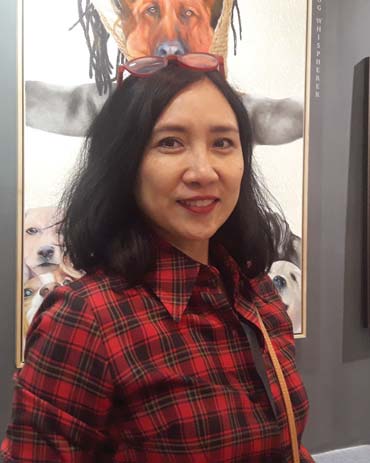
Vivi Yip: There is room for improvement especially in inviting the right people to the fair and not just the social crowd.
Another local exhibitor was Vivi Yip, a former fair director of Art Jakarta. She showcased the works of Ang Che Che, Hendra Hehe Harsono, Novemto Komo, Ronald Apriyan and Theresia Agustina Sitompul.
“The works range from IDR20 million to IDR80 million. I introduced a few new artists to the market. Although they have gained international recognition, this is their first time at the art fair. They are Iwan Bagus, Hanoto Wibisono, Lie Fhung and Hari Budiono. “The market was a bit slow and we could see people actually taking time to carefully choose what they liked and interact with the artist, which is a good thing. Overall, the art fair committee did a great job. Of course, there is room for improvement, especially in inviting the right people to the fair and not just the social crowd,” Yip says, referring to selected “VIP collectors” from overseas who were there to socialise.
“The works range from IDR20 million to IDR80 million. I introduced a few new artists to the market. Although they have gained international recognition, this is their first time at the art fair. They are Iwan Bagus, Hanoto Wibisono, Lie Fhung and Hari Budiono. “The market was a bit slow and we could see people actually taking time to carefully choose what they liked and interact with the artist, which is a good thing. Overall, the art fair committee did a great job. Of course, there is room for improvement, especially in inviting the right people to the fair and not just the social crowd,” Yip says, referring to selected “VIP collectors” from overseas who were there to socialise.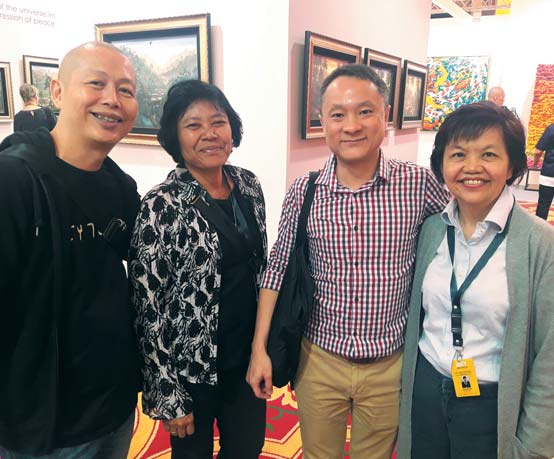
From left: Art fair visitor Joshua Lim, Dr Andonowati, art buyer Chiam Thow Hua and exhibitor U C Loh.
An Art Jakarta visitor, Irawan Hadikusumo, a collector and gallery owner from Surabaya, observes that despite the tough market conditions, there is still optimism, as there is a new generation of collectors on the scene.
Bandung-based Lawangwangi gallery director Dr Andonowati (who goes by one name) also reported good business at Art Jakarta. The former mathematics professor-turned-entrepreneur took up a “very large” booth measuring 11m by 4m, plus a special project booth. She also operates ArtSociates management consultancy.
The artworks shown were by local artists, namely, Eddy Susanto, Mujahidin Nurrahman, Etza Meisyara (under ArtSociates) as well as Tisna Sanjaya, Restu Taufik Akbar, Rendy Raka and Wiyoga Muhardanto. The prices ranged from US$1,800 to US$20,000.
“Our sales went very well. The works that cost above US$10,000 by Eddy Susanto and those under US$3,500 by Etza Meisyara sold the most. The reason is that Eddy is entering the young, bluechip artist category. Etza is a promising artist and her works are still affordable. All the good works were sold in the first two days,” says Andonowati.
She also participated in Art Stage Jakarta last year. She observes that there were more serious art buyers at that fair, while Art Jakarta attracted buyers who were “contractors, architects and designers”. With the cancellation of Art Stage Jakarta this year, “mainstream collectors” also came to the Art Jakarta fair.
In terms of selling, it is the best year for Art Jakarta, points out Andonowati. In terms of strength, the Art Jakarta team members are “truly friendly”.
“The fair director is very helpful and not arrogant. What’s lacking? I am not sure. Many would say they were not selective with the exhibitors chosen. But I am democratic, so for me, it is fine. Each gallery has its own clientele.”
“The fair director is very helpful and not arrogant. What’s lacking? I am not sure. Many would say they were not selective with the exhibitors chosen. But I am democratic, so for me, it is fine. Each gallery has its own clientele.”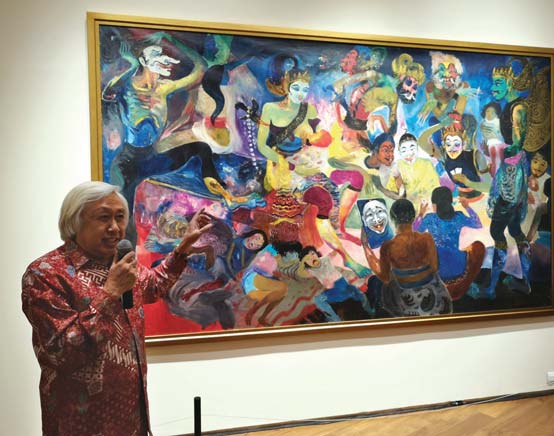
Art curator Agus Dermawan T giving a guided tour to media representatives attending the opening of the Hendra Gunawan: Prisoner of Hope exhibition at the Ciputra Artpreneur Museum in Jakarta.
Malaysian gallerists
While Malaysian gallerist Lim Wei-Ling declined to comment about the fair, fellow exhibitor U C Loh of Artemis Art in Kuala Lumpur, says her experience has been generally good.
“This is our third time joining Art Jakarta; we have not participated in Art Stage (Jakarta). I guess it doesn’t quite make sense to join both,” says Loh, who was at the fair with her husband S A Jamal.
“The crowd was still good in terms of numbers,as in previous years. But maybe this year, there were more bargain-hunters as well as those looking for decorative art. I’m not sure if this has any relation to the overall slowdown of the economy and overall slowdown in art purchasing,” she adds.
“From Malaysia, we showed the works of Eston Tan, and from Indonesia, we had Dedy Sufriadi, Gatot Indrajati, Indra Dodi, Afdhal, Taufik Ermas and Iqi Qoror. The small artworks ranged in price from US$350 to US$11,000. We sold all the small artworks, but it was not too good overall, compared with previous years. The committee might need to strategise on the direction of the fair. Are they out to capture more of the serious art collector market or a combination of that and the decorative art segment?
Hendra Gunawan
In conjunction with Art Jakarta 2018, Indonesian tycoon Dr (HC) Ir Ciputra launched the permanent exhibition of his collection of major paintings by the late iconic artist Hendra Gunawan.
Entitled Hendra Gunawan: Prisoner of Hope, the 32 paintings are said to be the largest collection of the modern artist’s works in Indonesia and include some that have never been exhibited, including paintings Hendra completed while he was jailed for 13 years from 1965 to 1978 at Kebun Waru prison. He was imprisoned for his political ideology and alleged involvement with Lekra, the People’s Art Movement in Indonesia that was active in the 1950s and 1960s.
Ciputra and Hendra Gunawan were close friends, especially during the final years of the artist’s life. The artist died in Bali in 1983. The exhibition was launched on Aug 4 at the Ciputra Artpreneur Museum to coincide with the 100th anniversary of Hendra’s birth on June 11, 1918. Managed by Rina Ciptura Sastrawinata, the glamorous daughter of the tycoon, the museum spans 700 sq m and is located at the Ciputra World 1 Jakarta building. The exhibition is open to the public with an admission fee.
Johnni Wong is Arts and Culture general manager of The Edge Media Group. He is involved in promoting Asian, particularly Malaysian, works of art.
This article appeared in Issue 846 (Sept 3) of The Edge Singapore.


